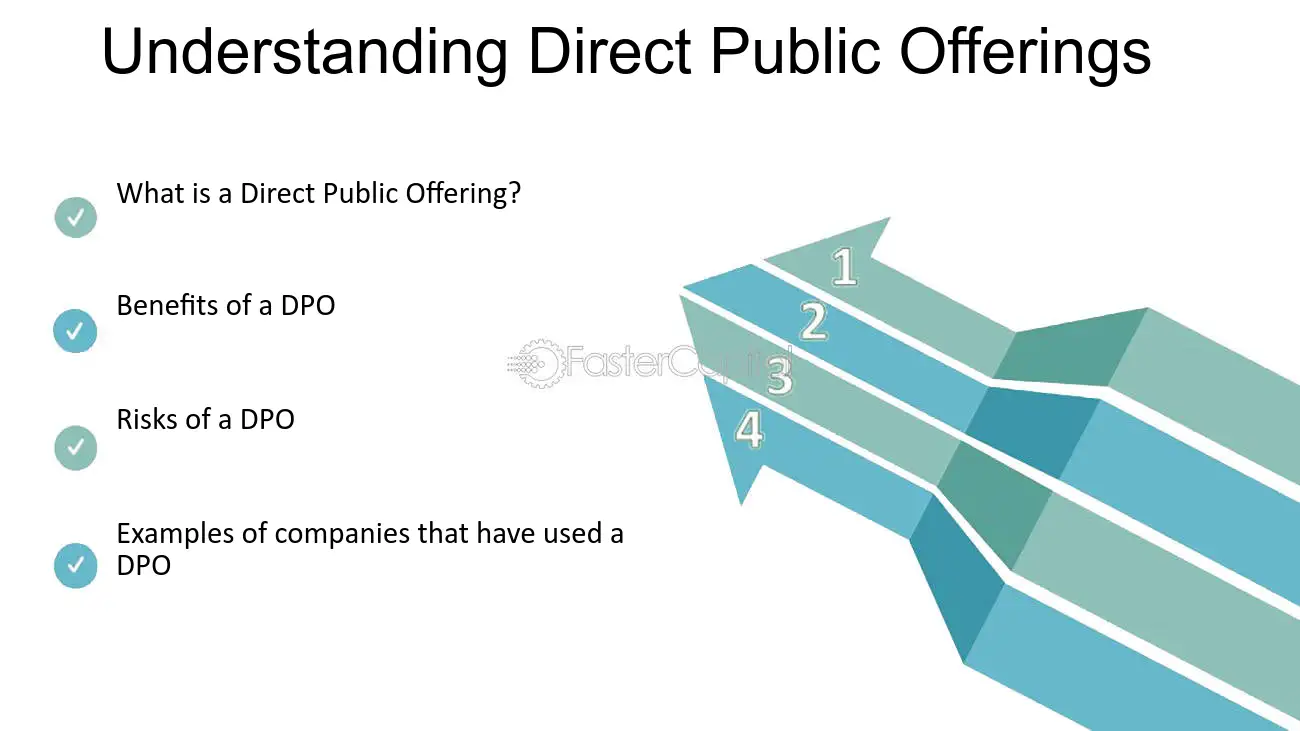What is Direct Public Offering (DPO)?
Direct Public Offering (DPO) is a method of raising capital for a company by offering its securities directly to the public, without the involvement of intermediaries such as investment banks. It allows companies to sell their shares or other securities directly to individual investors, bypassing the traditional initial public offering (IPO) process.
Unlike an IPO, where shares are typically sold to institutional investors and underwriters who then sell them to the public, a DPO allows companies to sell their securities directly to retail investors. This can provide companies with greater control over the offering process and potentially reduce costs associated with underwriting fees and other expenses.
Companies that choose to pursue a DPO may do so for a variety of reasons. It can be an attractive option for smaller companies or startups that may not meet the requirements or have the resources to go through the traditional IPO process. It can also be a way for companies to engage with their customers and supporters, allowing them to become shareholders and potentially benefit from the company’s success.
When conducting a DPO, companies must comply with securities regulations and file the necessary documents with the appropriate regulatory bodies. This typically includes preparing a prospectus or offering circular that provides information about the company, its business model, financials, and the risks associated with investing in the company.
In summary, a Direct Public Offering (DPO) is a method of raising capital by offering securities directly to the public, bypassing the traditional IPO process. It can provide companies with greater control and potentially reduce costs, while allowing individual investors to become shareholders in the company.
Definition and Explanation

A Direct Public Offering (DPO) is a method for companies to raise capital directly from the public without the involvement of intermediaries, such as investment banks. It allows companies to sell their securities, such as stocks or bonds, directly to individual investors.
Unlike traditional Initial Public Offerings (IPOs), which are typically underwritten by investment banks and involve a complex process, a DPO allows companies to bypass the middleman and directly connect with potential investors. This can make the fundraising process more accessible and cost-effective for companies, especially smaller ones.
During a DPO, companies can offer their securities through various channels, such as online platforms or through direct mail. They can also market their offering to a wider audience, including retail investors who may not have access to traditional IPOs.
One of the key advantages of a DPO is that it allows companies to maintain more control over the offering process. They can set the terms and conditions of the offering, including the pricing and the amount of securities to be sold. This can be particularly beneficial for companies that want to align their fundraising efforts with their values and goals.
However, conducting a DPO also comes with certain challenges. Companies need to comply with securities regulations and ensure that they provide accurate and transparent information to potential investors. They may also need to invest in marketing and investor relations efforts to attract investors and build trust.
In summary, a Direct Public Offering is a fundraising method that allows companies to sell their securities directly to the public. It offers companies more control over the offering process and can be a cost-effective alternative to traditional IPOs. However, it also requires careful compliance with regulations and effective marketing efforts to attract investors.
How Does Direct Public Offering Work?
Direct Public Offering (DPO) is a method of raising capital for a company by selling securities directly to the public, bypassing traditional intermediaries such as investment banks. This allows companies to raise funds without the need for an initial public offering (IPO) or the associated costs and regulatory requirements.
Here is a step-by-step breakdown of how a Direct Public Offering works:
| Step 1: | The company decides to raise capital through a Direct Public Offering and prepares the necessary documentation, including a prospectus that provides detailed information about the company, its financials, and the securities being offered. |
| Step 2: | |
| Step 3: | The company promotes the Direct Public Offering to potential investors through various channels, such as social media, advertising, and direct marketing. This helps to generate interest and attract investors who are interested in supporting the company’s growth. |
| Step 4: | Interested investors review the prospectus and conduct their own due diligence to assess the company’s financial health, market potential, and the risks associated with the investment. They can also seek advice from financial professionals or consult with their own advisors. |
| Step 5: | Investors who decide to participate in the Direct Public Offering can purchase the offered securities directly from the company. This can be done through an online platform or by contacting the company’s designated agent or transfer agent. |
| Step 6: | Once the offering period is closed, the company issues the securities to the investors and receives the funds raised. The investors become shareholders of the company and may be entitled to certain rights, such as voting rights and dividends. |
| Step 7: | The company uses the funds raised through the Direct Public Offering to finance its operations, expand its business, invest in research and development, or pursue other strategic initiatives outlined in the prospectus. |
Overall, Direct Public Offering provides companies with an alternative way to raise capital directly from the public, allowing them to retain control over the offering process and potentially save on costs associated with traditional IPOs. It also provides individual investors with an opportunity to invest in early-stage companies and support their growth.
Examples of Direct Public Offering
Direct Public Offering (DPO) is a method of raising capital for a company by selling its securities directly to the public without the involvement of intermediaries such as underwriters or investment banks. Here are a few examples of companies that have successfully utilized DPOs:
1. Ben & Jerry’s Homemade Holdings Inc.
Ben & Jerry’s, the well-known ice cream company, conducted a Direct Public Offering in 1984. The company offered shares of its stock directly to the public, allowing individuals to become shareholders and participate in the company’s growth. This DPO helped Ben & Jerry’s raise funds to expand its operations and increase its market presence.
2. BrewDog
BrewDog, a craft beer company based in Scotland, raised capital through a Direct Public Offering in 2009. The company offered shares to its customers and fans, allowing them to invest in the company and become part-owners. This unique approach to fundraising helped BrewDog build a loyal community of investors and supporters, and the company has since grown into one of the leading craft beer brands globally.
3. Etsy
Etsy, an online marketplace for handmade and vintage goods, conducted a Direct Public Offering in 2015. The company offered shares of its stock directly to individual investors, allowing them to participate in the company’s growth and success. This DPO helped Etsy raise funds to expand its platform and further develop its services, solidifying its position as a leading e-commerce platform for independent sellers.
These examples demonstrate the diverse range of companies that have successfully utilized Direct Public Offerings to raise capital and involve the public in their growth. DPOs can be an effective way for companies to access funding while also building a community of investors and supporters who are passionate about their products or services.
Direct Public Offering vs. Initial Public Offering (IPO)

Direct Public Offering (DPO) and Initial Public Offering (IPO) are two methods that companies can use to raise capital by selling shares of their stock to the public. While both methods involve selling shares to investors, there are some key differences between DPOs and IPOs.
DPO:
A Direct Public Offering is a method of raising capital where a company sells its shares directly to the public without the involvement of an underwriter or investment bank. This means that the company can save on underwriting fees and have more control over the offering process.
Benefits of a DPO:
- Lower costs: Without the involvement of an underwriter, companies can save on underwriting fees, which can be significant.
- More control: Companies have more control over the offering process and can set their own terms and conditions.
- Direct relationship with investors: By selling shares directly to the public, companies can establish a direct relationship with their investors.
IPO:
An Initial Public Offering is a method of raising capital where a company sells its shares to the public for the first time. In an IPO, the company usually works with an underwriter or investment bank to help facilitate the offering process.
Benefits of an IPO:
- Greater visibility: An IPO can generate significant media attention and increase the company’s visibility.
- Access to expertise: Working with an underwriter or investment bank can provide the company with access to expertise and guidance throughout the offering process.
Key Differences:
The main difference between a DPO and an IPO is the involvement of an underwriter or investment bank. In a DPO, the company sells shares directly to the public, while in an IPO, the company works with an underwriter to facilitate the offering process.
Additionally, DPOs are typically used by smaller companies or companies that have a strong following of loyal customers or supporters. IPOs, on the other hand, are more commonly used by larger companies that are looking to raise significant amounts of capital and increase their visibility.

Emily Bibb simplifies finance through bestselling books and articles, bridging complex concepts for everyday understanding. Engaging audiences via social media, she shares insights for financial success. Active in seminars and philanthropy, Bibb aims to create a more financially informed society, driven by her passion for empowering others.
